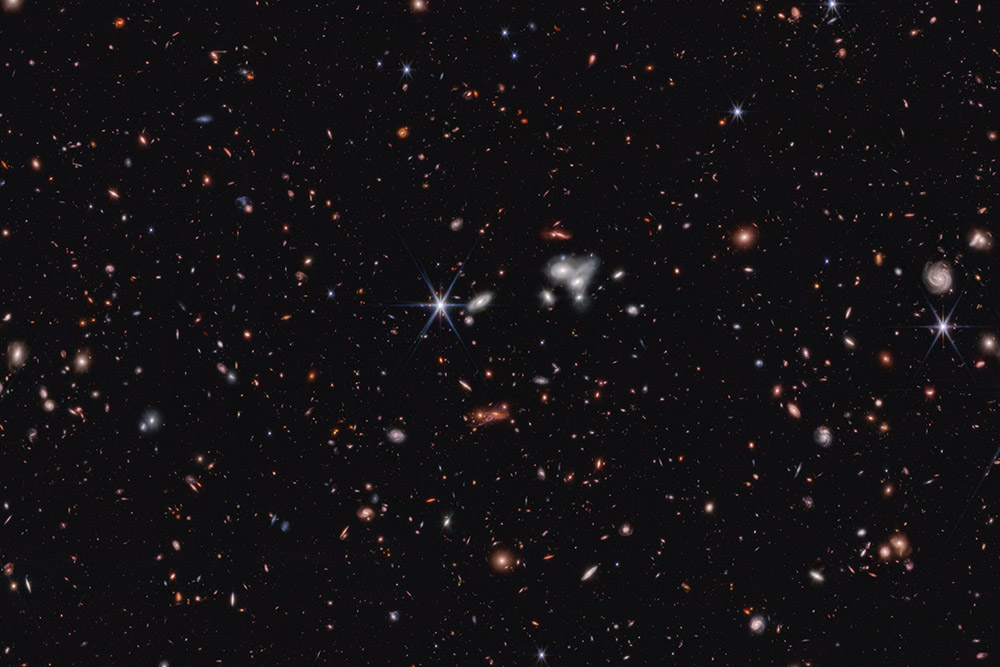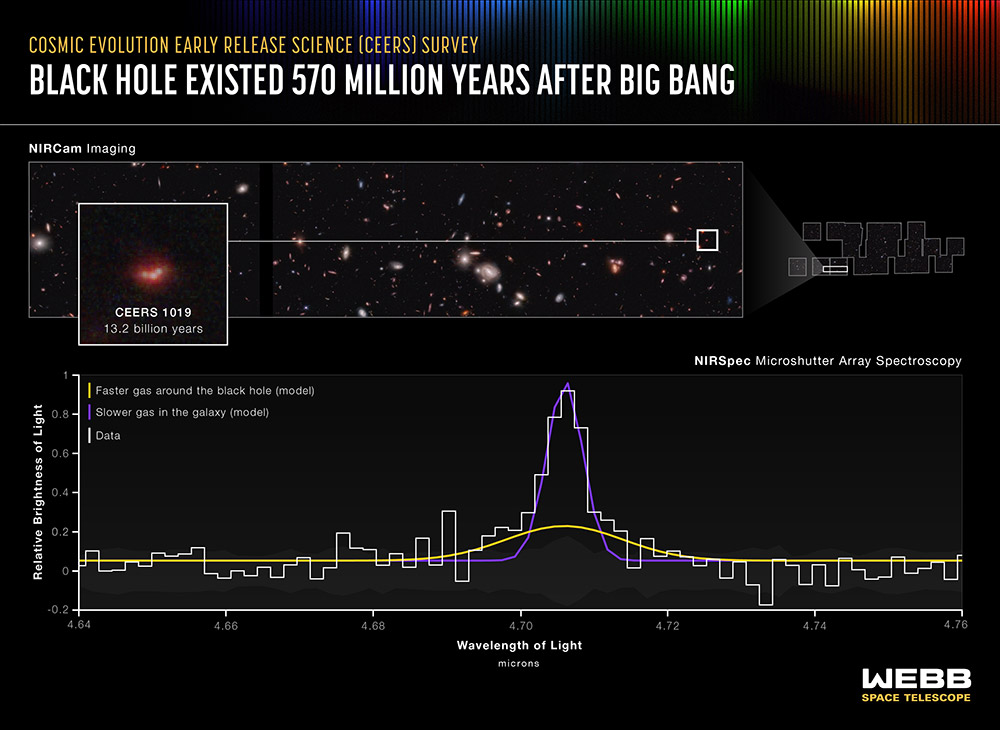RIT researchers discover most distant active black hole ever
Rebecca Larson and Jeyhan Kartaltepe part of James Webb Space Telescope CEERS observation team
NASA
A subset of the CEERS Survey images captured by the James Webb Space Telescope in near-infrared light.
A Rochester Institute of Technology postdoctoral researcher and an associate professor in the School of Physics and Astronomy, along with a team behind the Cosmic Evolution Early Release Science (CEERS) Survey, have used new observations from the James Webb Space Telescope (JWST) to confirm the existence of the most distant active supermassive black hole ever found.
The team has also identified several galaxies in the very early universe and low mass black holes in distant galaxies. This work has been accepted and published by The Astrophysical Journal Letters. The initial findings are the first steps in understanding how common these less massive black holes and galaxies might have been in the early universe.
NASA
This representation of CEERS 1019, observed by RIT researchers Rebecca Larson and Jeyhan Kartaltepe, shows that the black hole existed 570 million years after the Big Bang. This is the most distant active supermassive black hole ever found.
“This discovery shows us a time in cosmic history that we haven’t seen before,” said Rebecca Larson, a postdoctoral research associate in RIT’s School of Physics and Astronomy, who has been focused on the galaxy containing the newly discovered CEERS 1019 black hole for more than five years. “The data is exceeding expectations in almost every capacity.”
JWST was designed to observe the universe at near-infrared and mid-infrared wavelengths, which are longer than the wavelengths of visible light. That makes JWST a great tool for studying what the earliest galaxies in the universe looked like. The CEERS program combines JWST’s highly detailed images and data, known as spectra, all of which were used to make these discoveries.
As light travels from a distant galaxy toward us, it is gradually stretched into longer wavelengths and shifted toward the infrared part of the spectrum. Since the universe is expanding, the most distant light from the earliest galaxies has been shifted to the longer, redder wavelengths that can only be detected through infrared. The higher the “redshift” of a galaxy, the earlier it formed.
The active black hole in CEERS 1019 existed just over 570 million years after the Big Bang, and is further than any other yet identified in the early universe. CEERS 1019 is not only notable for how long ago it existed, but also for the surprising size of its black hole. This black hole clocks in at about 9 million solar masses, far less than other black holes that also existed at later times and were detected by other telescopes, but larger than what scientists expected to find so early in cosmic time.
Researchers have long known that smaller black holes must have existed earlier in the universe, but it wasn’t until JWST began observing that they were able to make definitive detections. JWST’s data is practically overflowing with precise information that makes these confirmations so easy to pull out of the data, according to Larson.
“We’re not used to seeing so much structure in images at these distances,” said Jeyhan Kartaltepe, RIT associate professor and a key player on the CEERS team. “In this galaxy we see complex structure with multiple components, suggesting that this black hole may be fueled by a galaxy merger.”
These are only some of the first groundbreaking findings from the CEERS survey. “These data have helped us refocus what we are trying to find and has made black holes become a major theme,” added Kartaltepe.
In addition to these celestial discoveries, Larson is also thrilled by the opportunity of collaborations with fellow scientists across the globe. “Many researchers brought in tons of data from different specialties to coordinate this program,” she said.
In addition to Larson and Kartaltepe, Santosh Harish, RIT postdoctoral researcher associate, and Isabella Cox, an RIT graduate student in the astrophysical sciences and technology program, were also involved in the project. Kartaltepe has been involved with JWST since its launch in 2021 as the principal investigator of COSMOS-Web, the largest General Observer program selected for JWST’s first year.
The team published several initial papers about CEERS Survey data in a special edition of The Astrophysical Journal Letters released on July 6: “A CEERS Discovery of an Accreting Supermassive Black Hole 570 Myr after the Big Bang: Identifying a Progenitor of Massive z > 6 Quasars,” led by Larson; “Hidden Little Monsters: Spectroscopic Identification of Low-Mass, Broad-Line AGN at z > 5 with CEERS,” led by Dale Kocevski of Colby College; “Spectroscopic confirmation of CEERS NIRCam-selected galaxies at z≃8−10,” led by Pablo Arrabal Haro of NSF’s NOIRLab; and “CEERS Spectroscopic Confirmation of NIRCam-Selected z ≳ 8 Galaxy Candidates with JWST/NIRSpec: Initial Characterization of their Properties,” led by Seiji Fujimoto of the University of Texas at Austin.











